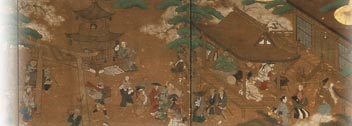Public Lecture "Joruri" Performance of a rarely performed piece, the "Ichiwaka's First Battle" scene from the gidayu play "Wada kassen onna maizuru"
< back
Outline
| date | Thursday, October 1, 2009, 14:00–16:00 |
|---|---|
| Venue | Okuma Small Auditorium |
| Organizer | Japanese Theatre Studies Course |
| outline | joruri: TOYOTAKE Hanafusa-dayu; shamisen: TSURUSAWA Seitomo; commentator: UCHIYAMA Mikiko |
Details
“Wada kassen onna maizuru” is a historical play in five acts that was first performed in 1736 at the Toyotakeza in Osaka. The final scene of the third act, “Ichiwaka’s First Battle,” was a piece that was universally praised before the war but all but dropped out of the repertoire after 1945. Nevertheless, TOYOTAKE Wakatayu X performed it during his name-taking ceremony in 1950 and later in life gave critically acclaimed performances of it in Tokyo and Osaka in 1965. For those of us who knew Wakatayu it is an unforgettable piece. Since Wakatayu performed it in 1965, it has never been given at a bunraku puppet theatre performance in Osaka. And although it was done once in Tokyo, it did not meet with an enthusiastic reception and has not been performed for the past twenty years.The Japanese Theatre Studies Course and the ningyo joruri bunraku study group asked TOYOTAKE Hanafusa-dayu, the grandson of TOYOTAKE Wakatayu X, to tackle the project in the hope of mounting a modern revival of the “Ichiwaka’s First Battle” scene from “Wada kassen onna maizuru”, a masterpiece of the Eastern vocal style, first performed by TOYOTAKE Wakatayu I (Echizen no Shojo); he and shamisen performer TSURUZAWA Seitomo agreed to undertake the project.
October 1, 2009 was set as the date for the public lecture “Joruri,” and before that Hanafusa-dayu and the joruri study group read through the “Ichiwaka’s First Battle” scene of “Wada kassen onna maizuru” over the course of two lecture meetings (March 24, 2008 and February 24, 2009) and on other occasions as well. The flyer for the public lecture “Joruri” refers to it as “the tragedy of Hangaku, who is caught up in the maelstrom of political controversy and forced to make a cruel choice.” What is that “cruel choice”? Why is Hangaku forced to make Ichiwaka kill himself? In the course of rereading the work, Hanafusa-dayu declared that Hangaku’s act was meant to save Ichiwaka’s honor.
The (pretty much generally accepted) negative criticism of this work that it is a cruel and unpleasant play in which a parent deceives her child, forces him to kill himself and substitutes him for someone else lost all grounds of support as a result of Hanafusa-dayu’s and Seitomo’s moving performance of “Ichiwaka’s First Battle” on October 1, 2009. “I am happy to have recited such a wonderful work,” said Hanafusa-dayu after the performance. “Ichiwaka is not a poor pathetic boy. In his own way this child lived a good life,” he said. Hanafusa-dayu and Seitomo were able to experience this work in a way that had not been possible for performers for more than twenty years, and indeed the same went for their audience.
“Ichiwaka’s First Battle” performed by Hanafusa-dayu and Seitomo was broadcast by NHK FM radio on October 10 at 11 am. Although, regrettably, cuts of ten minutes or more had to be made because of time constraints, it is fortunate that it was broadcast nationwide so that radio audiences might have the opportunity to reevaluate this work.
It might be mentioned in passing that this was the last time the present writer provided commentary as an acting teacher for the public lecture “Joruri” series, held repeatedly since 1981. (For more details about the public lecture “Joruri” series, see vol. 3 of “Engekieizogaku (Theatre and Film Studies) 2009.”)


